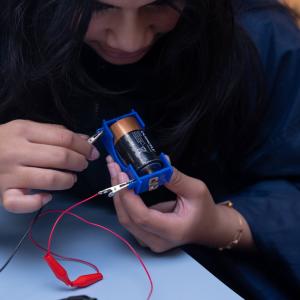Energy
When something changes, energy is involved. Energy is abstract but you can often detect it through the effect it has on your body: you can see patterns of light, you can feel the warmth created by heat energy, though you cannot see or feel magnetic energy. Energy from the Sun drives the growth of plants and the development of rainstorms, while energy from chemical reactions gives life to animals and is important to modern industry.
Some important characteristics of energy include:
- Energy exists in different forms, such as light, sound, heat, electricity and movement.
- Energy can be transformed (changed) from one form to another, for example, kicking a ball transforms chemical energy in our bodies to movement energy in the ball.
- Energy can be transferred from one location to another, for example, electrical energy moves along wires from a power station to our houses.
- Energy can be changed into other forms but it cannot be created or destroyed.
- Energy can be stored in many ways. Batteries and fossil fuels are stores of chemical energy.
Chemical energy
Chemical energy is energy stored in atoms and molecules. Chemical energy can be released in a chemical reaction, often in the form of heat. Examples of stored chemical energy include matches, batteries, petroleum, natural gas and dry wood. As each of these burns, they release chemical energy which is converted to thermal energy (heat) and light energy.
For example, a match has chemical energy stored in it. When the match is struck, it burns and the chemicals in it produces heat energy and light energy.
Heat energy
Heat is a form of energy created by the movement of molecules in an object. All matter is made up of atoms and molecules (groupings of atoms). The atoms and molecules of a material are always moving. Even objects which are very cold have some heat energy because their atoms and molecules are still moving.
When molecules get more energy in them than they had before, they move faster, and we call that heat. Things are described as ‘hot’ if their molecules are moving quickly and ‘cold’ if their molecules are moving more slowly. Temperature is a way of measuring how fast the molecules are moving.
Heat itself isn’t a ‘thing’ but rather a process of energy transfer. When two materials at different temperatures are placed in contact with each other, heat passes from one to the other until their temperatures are the same. For example, when you hold a cup of hot coffee, heat flows from the cup to your hand—the hot thing warms up a cooler thing by the transfer of heat or heat energy. This heat transfer is known as conduction.
How quickly heat is transferred between the two materials depends on several variables. The more surface contact between the materials, the faster the transfer. Different materials also ‘heat up’ at different speeds. When heat travels easily through a material it is known as a heat conductor, and when heat travels slowly the material is known as a heat insulator.
A metal spoon at room temperature is the same temperature as the air. It might feel colder than a wooden or plastic spoon because metal conducts heat so much better. Because your hand is hotter than room temperature, heat is conducted away from it, and a metal spoon ‘cools’ your hand faster. Heat flow depends strongly on the geometry and type of materials. For example, graphene, which is composed of just a single layer of carbon atoms and is the thinnest material in the world, is known for its fast heat transfer properties.
Heat has its origins in other forms of energy:
- The Sun changes nuclear energy into light and heat energy.
- A fire and living cells can change chemical energy into heat energy.
- Some electrical devices can change electrical energy into heat energy.
- Kinetic (motion) energy can be changed into heat energy through friction.
These are all examples of primary sources of heat. We might produce heat as a side product of any work we might do. Secondary sources of heat do not produce heat themselves but are previously heated by a primary heat source. If then moved to a cold environment they exchange heat with objects around them until all materials reach the same temperature.
Sound energy
Sound is produced by tiny, rapid vibrations in the particles that make up materials. This can be air, liquids or solids, but not in a vacuum or outer space, which have no particles. When the vibrations reach our ear, our brain translates the signal into what we call sound.
We define sound by what we can hear. Generally, human ears interpret sounds caused by an object vibrating between 20 and 20,000 hertz, abbreviated as Hz. 1 Hz means one vibration per second. Anything vibrating faster is called an ultrasonic vibration and is a higher pitch. Dogs have ears that can hear vibrations that are ultrasonic; this is why they can hear a dog whistle and humans cannot. Elephants communicate using subsonic vibrations below 20 hertz and, therefore, humans are unable to hear them.
Sound is produced when the energy of vibrating objects is carried away by pressure waves.
- Blowing into a recorder makes the air vibrate.
- Drawing a bow over a violin string makes the string vibrate.
- Hitting a drum makes its skin vibrate.
A vibrating object pushes the air, liquid or solid around it and then pulls away. These alternations of pushing and pulling create pressure waves in material. These are not up and down waves like those in water. The diagram below illustrates how waves of pressure travel through a slinky, a coil-shaped toy made from a ribbon of material.
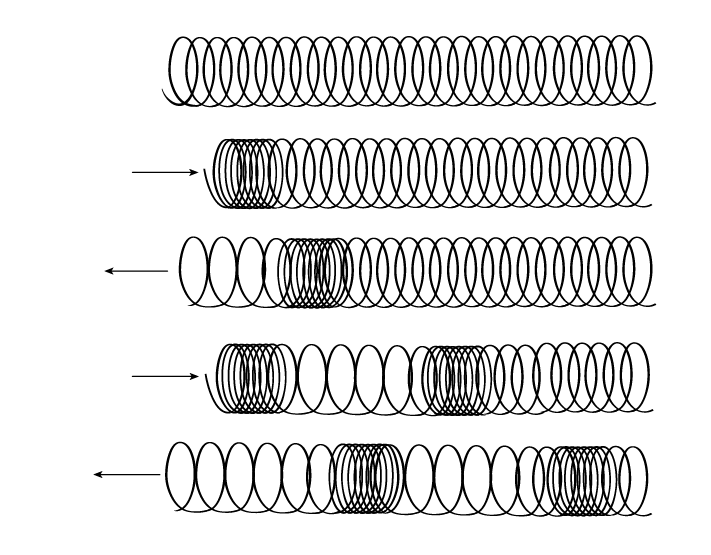
Diagram of pressure waves in a slinky
If the end of the slinky is quickly moved backward and forwards, a set of pulses travels along it. For each pulse, sections of coil are compressed and then stretched apart more than normal. The overall effect is the movement of a wave pattern along the slinky. While each coil moves backwards and forwards, the slinky as a whole does not move. In sound waves, the air molecules move backwards and forwards in a similar way. This occurs much more rapidly (and with much smaller-sized vibrations) than in a slinky. Because the air molecules are moving they have movement (or kinetic) energy.
A sound wave is a series of high-pressure and low-pressure zones. An object vibrating produces pressure waves in all of the materials around it. The sound energy spreads out in all directions from the source, unless the source is designed to send sound in a particular direction, like a loudspeaker or the horn of a trumpet.
Sound pressure makes a thin membrane—the eardrum—within the ear vibrate, and connected nerves then carry the signal to the brain, where it is interpreted as sound. The ear also hears the pressure waves travelling through water as sound, which is why we can hear with our head underwater. Pressing our ear to a solid, for example, a door, allows us to directly hear the pressure waves travelling through the solid.
The pressure waves that we call sound are a form of energy. All sound comes from another form of energy. For example, when we hit a drum the movement energy of our arm is transferred to the drum, which starts vibrating. The vibrations transfer some of the drum’s movement energy into sound energy in the air. Sound can be absorbed by materials if the energy contained in the pressure waves is transformed into different forms of energy. For example, sound energy could be transformed into heat energy when it hits sound-absorbing curtains.
Sound cannot exist without something to travel through. If you put an alarm clock in a vacuum the pieces will still be vibrating, but since there is nothing around them to transmit the vibrations, no sound waves can be produced.
Sound bounces off objects and therefore can produce echoes. In the mountains, the waves of pressure travelling through the air, generated by a shout, can travel to a cliff face opposite, bounce off and travel back through the air to the shouter’s ears. The further away the object that reflects the sound, the longer it takes to get back to the ears. Sound travels slowly compared with light, which is why we see a flash of lightning before hearing the thunder.
Light energy
Energy cannot be created or destroyed; therefore, light has its origins in other forms of energy. Primary light sources are things that change another form of energy into light energy. For example:
- The Sun changes nuclear energy into light energy.
- A fire, glow-worms and glow sticks change chemical energy into light energy.
- Light bulbs, lightning and computer screens change electrical energy into light energy.
Secondary light sources are things that reflect energy from a primary light source. For example, the Moon is a secondary light source that reflects light from the Sun.
The Sun is the Earth’s primary source of energy, emitting a broad spectrum of electromagnetic radiation, including sunlight. What we call light is a specific type of energy called ‘visible light’— the light that humans can see.
We know of nothing in our universe which travels faster than light. It races towards us through the vacuum of space at about 300,000 km per second. It takes a fraction of a second for light to cross Australia, about eight minutes for light from the Sun to reach the Earth, over four years for light to reach the next nearest star and 100,000 years for light to get from one side of the Milky Way Galaxy to the other.
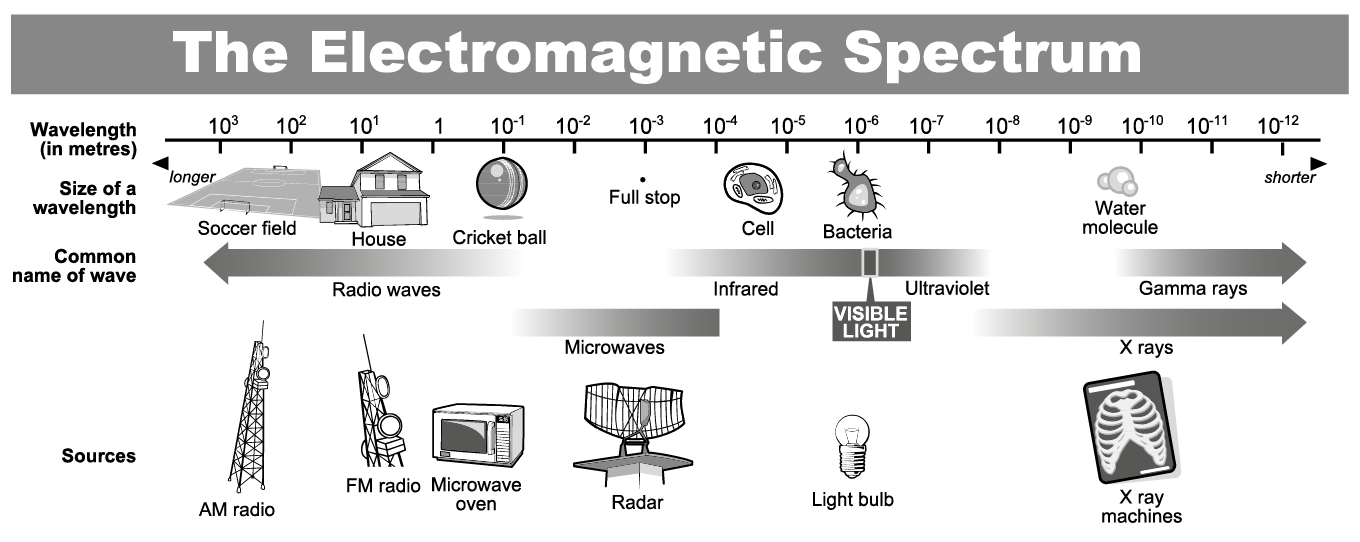
The range of the electromagnetic spectrum
Electromagnetic radiation
In ordinary situations electromagnetic radiation, including visible light, manifests as a wave. Careful experiments have shown that at a deeper level, electromagnetic radiation also consists of particles, or point-like packets of energy, called photons. How photons conspire to produce an ordinary wave can only be understood using advanced quantum physics.
Our eyes cannot detect all the electromagnetic radiation from the sun—only the ‘visible light’ can be seen. Other types of electromagnetic radiation include x-rays, ultraviolet and infrared light and radio waves. We can feel the infrared light as heat while the ultraviolet light can cause eye damage, sunburn or even skin cancer. The Earth’s atmosphere filters out much of the ultraviolet ‘UV’ radiation.
Light (unlike sound) does not need material to travel through. In a vacuum, for example, in interstellar space, all forms of electromagnetic radiation travel at the same speed regardless of their wavelengths. This speed is universally referred to as the speed of light.
Scientists call the distance between the crests of the waves wavelength, which is measured in metres. Waves with a very short wavelength, for example, gamma rays, will have many crests pass by in one second and are said to have a high frequency. Waves with a long wavelength, for example, radio waves, will have a lower frequency because fewer waves will pass by in one second.
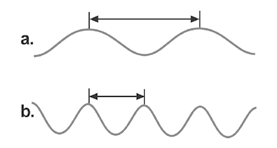
a. longer wavelength b. shorter wavelength
Visible light has a narrow range of wavelengths which are measured in micrometres. A micrometre is 1 millionth of a metre. These different wavelengths are evident as different colours. When all wavelengths of visible light are present, we see white light.
Shadows
We see objects only when light travels from the object to our eyes. These objects might be primary light sources that give out their own light, such as the Sun, an electric light or a candle, or they might be secondary light sources that reflect light to the eye. For example, the page of a book is a secondary source which you are able to read because it is reflecting the light from a primary light source (such as the sunlight coming through a window or an electric light). Once our eyes detect the light, information is transferred through the optic nerve to the brain, which then interprets the signals from the eye as an image of the object. Take away the light source or stop the light from reaching your eyes and you will no longer be able to see the object; it still exists, but you can no longer see it.
When a surface or object is coloured all the colours of the visible light are absorbed except for the colour of the object which is reflected. For example, a red object absorbs all colours except red, which is reflected. Thus, the object appears red. Black surfaces absorb all colours and reflect the least light. White surfaces reflect all colours and absorb the least light.
Ray diagrams use lines to show light travelling. The lines are straight because light travels in a straight line. Arrowheads show the direction of travel.
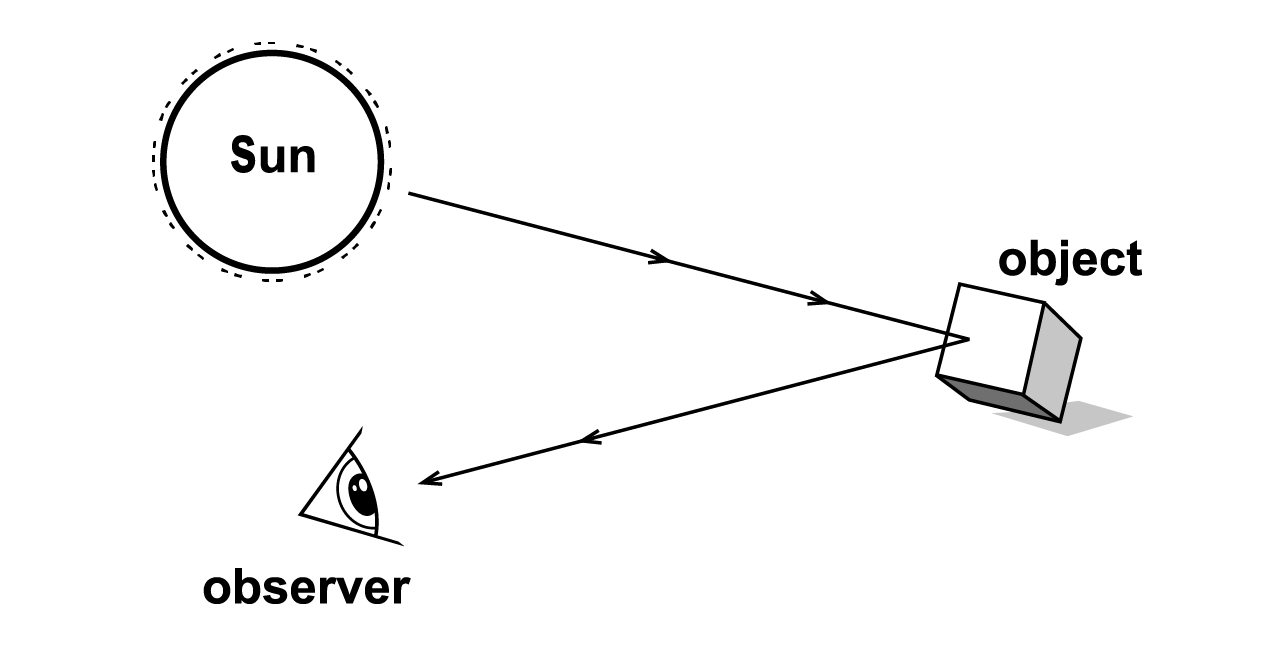
How we see
Shadows are formed because light does not go around objects to light up areas behind them. Light travels in approximately straight lines. Careful examination shows that near edges, there are changes in the light that can be attributed to the wave properties of light. The light appears to bend slightly as it passes near a sharp edge.
Shadows are dark shapes created when an object blocks out light. Materials that block out light are opaque, while materials that allow light to pass through them are transparent. The shape of a shadow is affected by:
- the shape of the object blocking the light
- how close the object is to the light source
- the position of the light source relative to the object, for example, whether it is above or at the same level as the object.
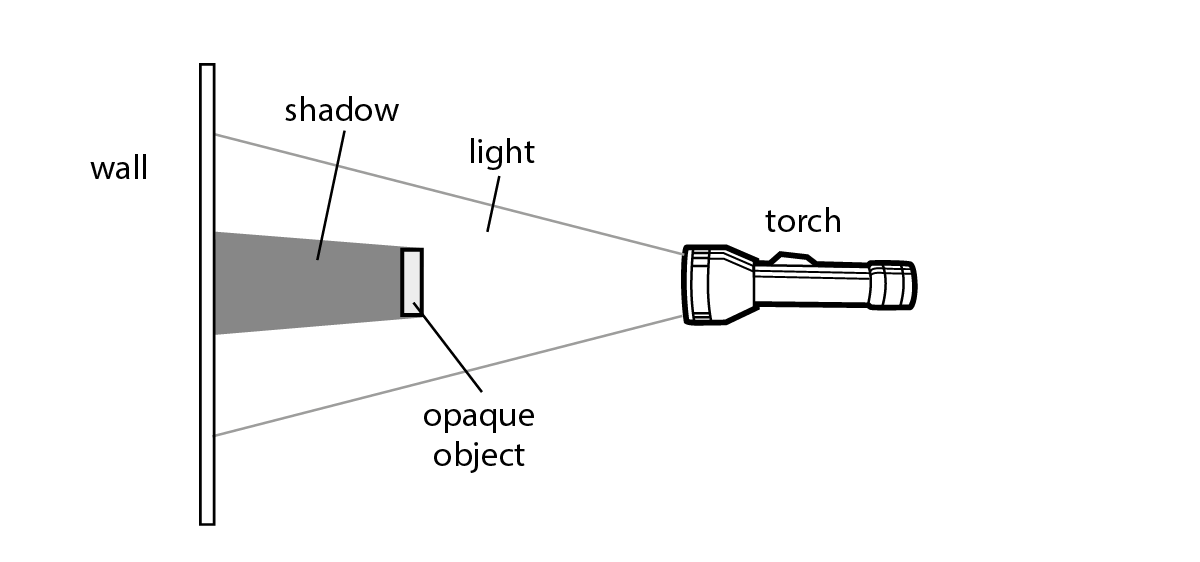
Casting shadows
When the position of the light source is right above the object, the object will cast a short shadow on the ground. As the light source moves downwards, the object will cast a longer shadow. This is why when the Sun is directly overhead, people and objects cast very small, short shadows. In the morning and afternoon when the Sun is low on the horizon, they cast very long shadows.
Reflection
When light from primary sources hits surfaces, it can be reflected, transmitted (let through) or absorbed (transformed into heat energy). Different surfaces reflect, transmit or absorb light in different ways. Some surfaces are very smooth and even. These reflect light in an ordered way and appear to be shiny. Other surfaces are more irregular. They reflect light in a scattered way and appear matt or dull. Some surfaces, for example, glass, transmit most light, reflecting very little, and thus appear transparent.
We can use these characteristics of light to manipulate it. Reflective surfaces can be used to direct light where we want it to go. A mirror is a very good reflective surface. It reflects light so well that we can see an image of an object placed in front of it. Light always reflects off a smooth surface at the same angle it strikes. Other surfaces will scatter the light in all directions because, at the microscopic level, the surface is uneven.
Refraction
Light travels at slightly different speeds through different mediums, such as water or air. When light travels from one medium to the other the change in speed can cause the light to change direction. This bending or refraction of the light can be seen when you view a pencil in water or the different colours as a rainbow. When light hits a piece of glass at an angle, the light changes direction (that is, it refracts). The change of direction is different for different colours. Consequently, when light hits a glass prism, the different colours can be seen because they are bent differently. The different bending is due to the different wavelengths interacting with the electrons in the glass differently. The result is that they appear to travel at different speeds.
The rate at which energy is carried by a light wave represents the intensity of the light. We perceive intensity as ‘brightness’. Theoretically, light waves from a source could travel forever. The intensity of light from the source will decrease rapidly as we increase our distance from the source because the light will spread out and will usually meet some material, for example, dust in the air. This will cause it to be reflected or scattered or absorbed, and thus the light might not be seen over a large distance.
In a vacuum, for example, interstellar space, all forms of electromagnetic radiation travel at the same speed regardless of their wavelengths. This speed is universally referred to as the speed of light.
Electrical energy
An electrical circuit is a complete path of conductive material through which electricity flows. Electricity will not flow in a circuit that is not complete, so switches are introduced into circuits to allow us to easily control when the electrical current flows. The wires in our homes carry the electricity to appliances, which use a certain amount of electrical energy. If the appliance malfunctions, and too much electrical energy flows through the circuit, the fuse boxes in our homes protect us by breaking the circuit before the excess energy causes damage.
Conducting electricity
All materials are made of atoms. Atoms have a central core composed of protons (that have a positive charge) and neutrons (that have no charge). This core is surrounded by a ’cloud‘ of very small, negatively charged particles called electrons. In some materials, particularly metals, the outermost electrons can leave the cloud around their core and jump to others. This occurs in all the atoms in a piece of metal, creating a cloud of randomly moving electrons shared by all the atoms. This makes metals able to conduct electricity and is also what gives metals their shimmer. The electrons in insulators cannot easily move away from their cores, which prevents them from conducting electricity.
Electrons travel easiest along conductors such as wires. A switch is simply a device that either connects two wires or keeps them apart. When a switch is ‘on’ the electrons have a path through the switch, when the switch is ‘off’ the path is broken and the wires are not connected.
Electrical circuits
The electrical circuit in a torch includes a battery (or batteries), connecting wires, a switch, and a light bulb. When the battery is inserted in the torch and the switch is turned on there is a complete path, or circuit, and the electrons can flow from the negative terminal of the battery around the circuit to the positive terminal.
When the switch is closed (the ‘ON’ position), the electrons in the circuit start moving in a single direction, rather than randomly as before. The electrons move from the negative terminal of the battery towards the positive terminal through the metal of the wires, switch and lamp filament.
The electrons themselves move very slowly, measured in centimetres per minute. However when you complete the circuit by turning on the switch the light bulb begins to glow almost immediately. This is because the wires are already full of electrons, and so it is like a bicycle chain connected to the pedals of a bicycle. When you put pressure on the pedal, the wheel turns at once even though the chain links near the pedal have not yet reached the wheel. The source of electrical energy creates an electric field across the whole circuit, pushing all the loose electrons in the circuit to start moving at once.
Batteries
When a battery’s positive and negative terminals are connected by the wires, switch, and lamp in a circuit, the chemicals within it react, transforming the chemical energy into electrical energy and causing the electrons to move around the circuit. If the terminals are connected to each other directly through a material with high conductivity, for example, a wire, the chemicals in the battery will react very quickly, causing a high flow of electrons through the circuit. The chemical energy is released very quickly, often causing the battery to become warm. The high flow of electrons may also cause the wire to become very warm and possibly even burn through.
Conductors and insulators
Some materials contain electrons that are held loosely by the atoms and are free to move throughout the material. This means that they can form part of an electrical circuit. They are called electrical conductors. Metals have many free electrons and are considered to be good conductors.
Materials such as glass or plastic have electrons that are not free to move. Therefore, they do not allow electrons to flow through them and are called insulators. Common insulators include plastics, rubber, wood and glass. A plastic insulator is used on electric switches and wires to prevent shock or electrical injury to a person using them.
The human body is a conductive material and people can be harmed if they become part of an electrical circuit with a voltage higher than about 40V. The danger depends on the amount of electrical energy (voltage) in the circuit. Electrical energy above a certain threshold will cause muscle contraction, meaning if a person touches a wire with the palm of their open hand, the hand snaps shut, and they cannot detach themselves from the current. Length of contact, amount of electrical energy and factors like sweat on skin determine the severity of symptoms, from burns to interfering with the functioning of the heart and the nervous system.
Kinetic energy (Motion energy)
All moving things have kinetic energy. It is energy possessed by an object due to its motion or movement. The heavier a thing is and the faster it moves the more kinetic energy it has.
Energy can be transferred and transformed from one for to another and is conserved within systems.
This list of alternative conceptions is not meant to be comprehensive, but instead aims to provide a starting point.
Alternative conception | Accepted conception |
| Energy is used up. | Energy may be transformed or transferred but it is always conserved. |
| Energy is a ‘thing’ | Materials and objects can have energy transferred to them. |
| Energy and force are interchangeable | A force is an external effect that can cause an object to change its speed, shape, or direction. Leaning on a desk applies a push force on the desk. This force exists even if the desk does not move (it could cause change if the net force was unbalanced). Force is applied to an object, not transferred. Energy is a property of a system associated with the extent of movement of an object or the amount of heat within it. Energy changes from one form to another can be tracked. |
| Only living things have energy. | Energy can be transferred between objects. Batteries have chemical energy, cars have kinetic/motion energy. |
| Only objects in motion have energy. | Potential energy is the energy stored in a coiled spring, in a battery (chemical energy), or in an object that can fall. |
| Loudness and pitch are the same thing. | Pitch is how high or low a note is, while loudness is how loud or soft the note is. |
| Sound moves faster in the air than solids. | Sound needs particles to be transmitted. The closer together the particles (solid) the faster the sound will move. |
| You can see and hear an object far away at the same time. | Light travels faster than sound. |
| You can scream in space. | Sound requires a medium (with particles close enough to bump together) to be transmitted. This does not occur in space. |
| Heat is a kind of substance. | Heat is a form of energy that can be transferred or transformed. |
| Things expand when heated to make room for heat. | When objects are heated, they particles gain kinetic/movement energy. This faster movement means they take up more space and the object can expand. |
| Heat travels like fluid through objects. | Heat travels by conduction, convection, or radiation. |
| Objects in the same room can be at different temperatures (metals will be colder than wood). | Metals are good conductors of heat. Touching metal in a cold room will conduct the heat away from your body (making your hand and the metal feel cold). Wood does not conduct heat as well as metal. This keeps the heat in your hand (wood feels warmer than metal). |
| Things wrapped in an insulator will warm up. | An insulator maintains the heat in an object. A heat source is needed for an object to ‘warm up’. |
| The eyes produce light (cartoon-like) so we can see objects. | Light is a form of energy that comes from a source (not human eyes). |
| We see an object when light shines on it. | We see objects when the light bounces off an object and reaches our eyes. |
| White light is a colour. | The primary colours of light are green, blue, and red. When these are mixed, they produce white light. |
| A prism adds colour to light. | The different wavelengths of visible light bend in different amounts as they pass through a prism. This spreads the colours/wavelengths and produces a rainbow. |
| The grass is green because it produces green light. | The green leaves of grass reflect most of the green light (and absorb other colours). This is why we see the green colour. |
| The primary colours of light are the same as paint. | The primary colours of light are green, blue, and red. Mixing red and green light produces yellow light. |
| When light moves through a coloured filter, the filter adds the colour to the light. | A coloured filter selectively absorbs some colours and lets others through. For example, a red filter only lets red light through. |
| Light from a bulb only extends out a certain distance and then stops. | Light is spread over a greater area as it moves away from the source. This means there is less that reaches our eyes. |
| A mirror reverses everything. | Mirrors reverse images left to right (not up and down) |
| Light does not reflect from dull surfaces. | We see an object because it is a light source or the light has been reflected from its surface. |
| Light from a bright light travels further than light from a dim light. | The brightness of a light indicates the number of photons (packets of light) that are able to travel from the source to your eye. The light always travels the same distance but spreads out. More photons will reach your eye even when far away. |
| Static electricity and current electricity are two different things. | Both static and current involve electrically charged particles. In static electricity, the charged particles do not have a pathway to move. Current electricity has a pathway (usually wire). |
| Energy in an electric circuit is used by a light globe | Electrical energy is transformed at the globe to light and heat energy. |
| Batteries store electrical energy. | Batteries store chemicals (chemical energy) that react to produce electricity in connecting wires. |
| You only need 1 wire to make a circuit. | Electricity must be able to flow from the negative terminal of a battery to the positive terminal. Most electrical cords that plug into the mains power contain at least 2 wires to complete a circuit. |
| The plastic in the wires keeps the electricity in (like water in a pipe). | Wires do not need plastic coating for the electrical current to flow. It does prevent potential short circuits. |
| Current is ‘used up’ in a circuit | The current stays the same value in all locations of a series circuit. |
| The current moves from one end of the battery to the light. | When the battery is connected to a circuit, the current starts flowing in all parts of the circuit at the same time. |
| Positive current leaves one end of the battery and negative current leaves the other end, these clash at the light bulb. | When the battery is connected to a circuit, the current (electrons from negative to positive terminals) starts flowing around the circuit at the same time. |
| Voltage is energy. | Voltage is a measure of the electrical potential energy in a circuit. |
| Touching a high-voltage wire will kill you. | Birds are able to sit on a high voltage wire. If an object was to touch a high voltage wire at the same time they were touching the ground, current would flow through them and cause damage. |
| The bigger the battery, the more voltage. | The voltage provided by the battery is determined by the manufacturer. Button batteries can be 3 v, while AAA batteries are 1.5 v. |
| Alternating current (AC) moves all the way around a circuit and back again. | When the battery is connected to a circuit, the current (electrons from negative to positive terminals) starts flowing round the circuit at the same time. Alternative current changes direction 50 times/second. |
References
AITSL. (n.d.). Resource. AITSL. https://www.aitsl.edu.au/tools-resources/resource/dispelling-scientific-misconceptions-illustration-of-practice
Allen, M. (2019). Misconceptions in Primary Science 3e. McGraw-hill education (UK).
Ideas for Teaching Science: Years 5-10. (2014, April 14). Resources for Teaching Science. https://blogs.deakin.edu.au/sci-enviro-ed/years-5-10/
Pine, K., Messer, D., & St. John, K. (2001). Children's misconceptions in primary science: A survey of teachers' views. Research in Science & Technological Education, 19(1), 79-96.
Redhead, K. (2018). Common Misconceptions. Primary Science Teaching Trust. https://pstt.org.uk/resources/common-misconceptions/
University of California. (2022, April 21). Correcting misconceptions - Understanding Science. Understanding Science - How Science REALLY Works... https://undsci.berkeley.edu/for-educators/prepare-and-plan/correcting-misconceptions/
